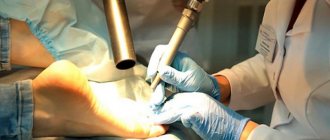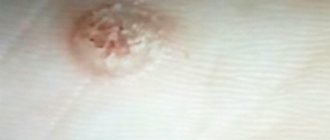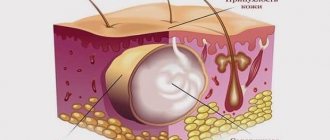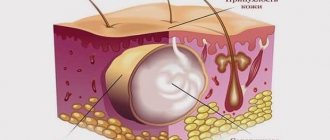Friction of the skin on hard surfaces causes detachment of the epidermis from the underlying layers of the dermis, followed by the formation of a cavity filled with clear intercellular fluid. The formation caused by mechanical damage to the skin is nothing more than a wet or soft callus, colloquially called dropsy. The phenomenon is so common that no one can be protected from wet calluses. And although this kind of damage in most cases is minor and does not pose any serious danger to health, when walking they cause considerable discomfort.
If you ignore the problem, the bubble may burst. And in its place there will be an inflamed, wet wound of bright pink color, open to any infection. Infection of the wound area is fraught with problems much more serious than discomfort and pain when walking. Therefore, treatment of wet calluses should not be taken lightly. You need to start doing something as soon as dropsy appears on the foot, and not wait for complications. How to treat a wet callus on the foot is described in detail below.
Baths for wet calluses
Fresh soft calluses respond well to treatment at home using accessible folk methods. First of all, these are therapeutic foot baths.
Foot baths when treating water calluses should not be hot. The optimal water temperature is 36C.
A simple remedy such as table or sea salt will help to disinfect the surface of the skin, dry the callus and stimulate rapid healing of the wound. To prepare a therapeutic foot bath, you need to dissolve a tablespoon of salt in a liter of lukewarm water. Immerse the painful area of the foot in this solution for 2-5 minutes. If you don’t have time to take a bath, you can simply wipe the callus with cotton wool soaked in a saline solution.
A bath with potassium permanganate helps quickly get rid of soft calluses. A weak, pale pink solution is prepared from potassium permanganate powder. Immerse your feet in it for 5 minutes. Potassium permanganate has a pronounced disinfectant property, dries the wound well, and relieves inflammation.
After therapeutic baths, the skin in the area of damage is carefully blotted with a terry towel so as not to damage the bladder. To relieve pain and inflammation, and prevent excessive dryness and cracking of the skin, it is recommended to lubricate the blister with vegetable oil.
Symptoms and treatment of calluses
Dry callus is not always easy to recognize. They are sometimes confused with corns .
Unlike calluses, calluses are usually large and vaguely outlined, while dry calluses are small, flat, round areas of rough, yellowish skin. Most often, calluses occur on the soles of the feet, as well as on the top and sides of the toes.
To combat dry calluses, various products are produced that soften dead skin. When using these products, it is easy to remove rough skin with a special scraper, which significantly reduces the growth and relieves pain when pressure is placed on the feet.
How to treat a wet callus with herbs
Young wet calluses are treated with medicinal plants. For example, plantain. As soon as the shoes begin to rub the skin, you need to pick a plantain leaf, wash it and crush it in your hands. Apply to the callus and secure the improvised compress with a bandage or adhesive plaster.
Plantain relieves pain, inflammation, disinfects and heals wounds. The only drawback of this method is that it is practically inapplicable in urban environments. Therefore, we have to look for other options for simple, effective treatment of soft calluses with folk remedies.
An excellent, completely safe remedy for dropsy on the legs, which can be used at home at a convenient time - baths made from decoctions of medicinal herbs. Chamomile and calendula are best suited for these purposes. Both plants are known for their wound-healing, antibacterial, and drying effects, so warm foot baths from decoctions of these herbs help to cope with soft calluses in just a couple of days.
In addition to baths to get rid of water calluses, you can make compresses from the pulp and juice of aloe and Kalanchoe:
Cut a small piece from a thick green leaf of aloe (Kalanchoe) and rinse with water.- Cut in half lengthwise.
- A slice with sticky pulp is applied to the callus.
- Cover the top with a sterile bandage.
- Secure the compress with a regular adhesive plaster.
This compress should be worn without touching for 24 hours. Then remove, treat the callus with an antiseptic and make a new compress. Continue treatment until the callus is completely healed.
Why do calluses reoccur?
There is an opinion that remedies for dry calluses do not completely eliminate the problem, because after some time (usually after a few months) the problem returns.
This misconception arises due to the fact that, after completing the course of treatment and getting rid of dry calluses, people often continue to wear the same inappropriate shoes that caused the calluses to appear.
The return of calluses can be caused by other foot conditions, such as bunions, which make the toes more susceptible to friction and pressure, which in turn leads to the formation of calluses.
How to open dropsy correctly
Opening a blister is allowed only if the callus is large, causes severe pain, discomfort and can burst when walking even under a band-aid. You just need to do this according to certain rules:
It is advisable to pierce fresh dropsy that has appeared within the last 24 hours.- Use sterile materials for the procedure. Pre-heat the needle over an open flame or immerse it in pure medical alcohol for a few seconds.
- Before the procedure, treat the walls of the blister and the skin around it with an antiseptic and disinfect it well.
- Make a puncture at the base of the bladder, holding the needle parallel to the surface of the skin. You cannot pierce the water callus from above, since the tip of the needle can injure the tissue under the bubble. If the callus is large, you can make several punctures around the perimeter of the blister.
- After opening, apply a piece of sterile bandage or gauze directly to the callus. Press lightly so that all liquid comes out of the cavity.
- Apply an antibacterial ointment to the opened water callus to prevent the possibility of infection getting into the fresh wound.
At the end of the procedure, the treated area of the foot is covered with a bactericidal bandage or callus plaster. The dressing is changed twice a day. Be sure to remove it at night so the skin can breathe.
If everything is done correctly, the wet callus will disappear within a few days. If the wound becomes infected, no independent action should be taken. Without waiting for the infection to develop, you need to seek help from a dermatologist and begin treatment in accordance with the recommendations of a specialist.
How to prevent calluses from forming
Although wet calluses most often heal on their own, you must agree that it is better that they do not appear at all. Fortunately, it is possible to prevent the formation of calluses.
- Buy shoes by size, remember that the most important trend is not the model and style, but comfort. You can read advice from a doctor on how to choose the right new pair of shoes in this material.
- Before going on long walks or playing sports, you can “break in” your new shoes a little at home, putting them on for 10–15 minutes every day.
- Wear socks that absorb and wick moisture well. As a rule, these are cotton socks and hosiery with a small synthetic content. Change your socks as needed, but at least once a day.
- Use cotton gloves with special rubber inserts if you develop calluses on your palms as a result of sports or physical labor.
- To prevent the formation of calluses, you can also seal the most vulnerable area of the skin with a band-aid before upcoming exercise, and also use talc (baby powder) to prevent excess moisture in the skin.
Education mechanism
Water calluses (dropsy) - appear due to friction or squeezing of the skin. The most common cause of formation: wearing tight and uncomfortable shoes. The main localization is on the feet, big toe and little finger, on the heel. Visually, such a growth resembles a bubble filled with liquid.
Many patients ask the question: “What is the liquid in the callus and where does it come from?” To answer this question, consider the mechanism of blister formation:
With strong, prolonged friction, the soft tissues are exfoliated: the upper layer of the epidermis is separated from the lower, and the space between them is filled with intercellular fluid. It consists of plasma and secreted from the blood. It contains white blood cells that fight inflammation and germs. Plasma fluid protects the dermis from further abrasion.
Water calluses on the feet cause discomfort, pain and burning. It is recommended to immediately take measures to eliminate them, preventing infection.
Calluses
Calluses are a phenomenon that occurs due to prolonged friction or pressure on the skin. They are more often found in men; if left untreated, they can cause significant discomfort and even serve as a favorable environment for the development of infection. The “favorite” places for chafing to appear are the heel, the area between the first and second toes, and the edges of the feet. You should be more attentive to your health if calluses appear frequently - perhaps this indicates problems with an overloaded spine and your feet are signaling you about this.
Reasons for appearance
Callus develops due to many factors:
- tight shoes that don't fit;
- high heels and uneven load on the feet;
- elements of shoes cutting into the skin;
- Socks that are too big and cause chafing;
- individual characteristics of the skin with a tendency to severe keratinization;
- a consequence of specific professions with heavy workloads (athletes, farmers, etc.);
- mycoses of the foot, age-related dry skin;
- increased sweating.
Some diseases can also cause calluses. These are flat feet, diabetes, psoriasis, and also a lack of vitamins in the body. The first signs of the imminent appearance of calluses are redness of the skin, slight swelling, and pain when touched.
Types of calluses
Calluses are divided into several types:
- Wet:
looks like a bubble filled with liquid (lymph). Its color is usually transparent, but if small blood vessels are affected, it becomes reddish. The remains of a burst bladder give rise to the growth of dry callus. - Dry:
This is a slightly raised area of keratinized cells that is grayish-yellow in color. Consists of several layers of hardened tissue. - Rod (with 1 or several rods):
in the center of such calluses there is a hole where a rod grows, going deep into the dermis. Deeply growing core calluses bring pain; - Corns:
Similar to dry calluses, but still different. Calluses appear on both the hands and feet and have visible boundaries, while corns are characteristic only of the lower surface of the feet and are larger in size, and they do not have a clear limitation or core.
Diagnostics
A podiatrist can determine the type of callus by its appearance. It must be distinguished from heel spurs (internal growths on the bone) because the spurs cannot be treated with therapy designed to remove calluses. Any callus is not only an aesthetic defect, but also a potential opportunity for infection, so this problem should not be left untreated.
Callus removal
It is better to remove calluses in a clinic where the patient is offered a suitable type of defect destruction - medical pedicure, laser burning, cryodestruction. All these methods are effective and safe for the body, allowing you to quickly get your skin in order. Core calluses require special attention, because a core that is not completely excised can cause relapse. After removing the formation, the skin is treated with an anti-inflammatory (and, if necessary, antifungal) agent. It is mandatory to select orthopedic shoes and reduce the load on the foot by wearing insoles, pads, and arch supports.
Prices










